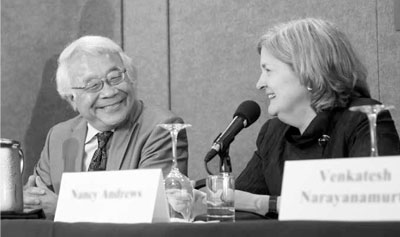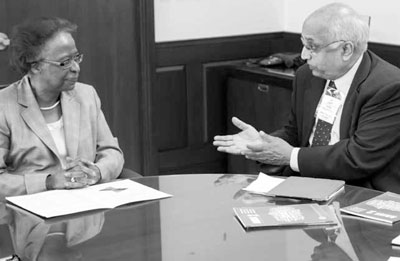A new Academy report, ARISE II: Unleashing America’s Research & Innovation Enterprise, offers recommendations for academia, government, and the private sector to help maintain America’s leadership in science, technology, and medicine. ARISE II highlights the need for greater synergy between government, university, and industry research. It advocates for greater integration of theories, concepts, and applications from multiple scientific disciplines – biology, physics, medicine, engineering, and computer science – to solve the complex problems of the twenty-first century.
“Scientific and technological innovation has been vital to the economic prosperity and security of the United States,” said Academy President Leslie Berlowitz. “Yet there is growing concern that the nation risks losing its position of global technological leadership. ARISE II examines the factors affecting America’s productivity in science and technology and suggests steps to encourage transdisciplinary and trans-sector research collaborations.”
 Keith Yamamoto (University of California, San Francisco) and Nancy Andrews (Duke University School of Medicine) |
The Academy released ARISE II on May 1, 2013, at the National Press Club in Washington, D.C., to an audience of government officials, journalists, and scientific leaders from universities, NGOs, and professional societies. Project cochairs Venkatesh Narayanamurti (Harvard University) and Keith Yamamoto (University of California, San Francisco) and committee member Nancy Andrews (Duke University School of Medicine) outlined the overarching goals and recommendations of the report.
Yamamoto observed that “progress illuminates new opportunities, but how we find them, much less take advantage of them, will depend on new modes of communication and cooperation across the sectors. There are opportunities for scientific research to address not only big scientific questions that are exciting in their own right, but also important societal issues that probably can’t be solved in any other way: issues in health, environment, energy, food, and agriculture.”
“Our objective is to break down barriers that still exist, to promote real sharing of tools and expertise, and to incentivize integrative approaches across traditional disciplines,” said Andrews.
Narayanamurti remarked: “To connect research with the larger enterprise of discovery and innovation, we must involve industry. Because of the decline of research in the industrial laboratories in both the pharmaceutical and physical science sectors, it is important that much more such work be done in our universities and national laboratories – meaning that how industry funds science must change for the long term.”
The ARISE II committee includes many of the nation’s preeminent scientists and policy leaders from government, academia, and business.
 Cora Marrett (National Science Foundation) and Venkatesh Narayanamurti (Harvard University) |
Engaging Key Stakeholders
Project leaders recently met with Cora Marrett, Academy Fellow and Acting Director of the National Science Foundation (NSF), and NSF Assistant Directors Fleming Crim (Mathematical and Physical Sciences), John Wingfield (Biological Sciences), and Pramod Khargonekar (Engineering) to discuss the report’s recommendations. In addition, the project leaders briefed senior policy staff from university and industry associations, including the Association of Public and Land-Grant Universities; the Association of American Universities; the American Association for the Advancement of Science; the Biotechnology Industry Association; the National Association of Manufacturers; and Battelle Memorial Institute, operator of several U.S. national laboratories.
The Academy released its first ARISE report, Advancing Research In Science and Engineering: Investing in Early-Career Scientists and High-Risk, High-Reward Research, in 2008. Chaired by Thomas R. Cech, Distinguished Professor at the University of Colorado Boulder and former President of the Howard Hughes Medical Institute, ARISE I addressed two critical issues: waning support for young investigators and the need to encourage potentially transformative research. The recommendations from ARISE I were incorporated into the American Recovery and Reinvestment Act of 2009 and subsequent federal budgets. The Department of Energy, the National Science Foundation, and the National Institutes of Health have all increased support for early-career researchers and potentially transformative research, as recommended in ARISE I.
The ARISE II report is available online at www.amacad.org/arise2.pdf.
The Academy is grateful to the S. D. Bechtel, Jr. Foundation, the Richard Lounsbery Foundation, the Research Corporation for Science Advancement, and the Gordon and Betty Moore Foundation for their support of the ARISE II project.
ARISE II Committee |
|
| Cochairs Venkatesh Narayanamurti, Harvard University Keith R. Yamamoto, University of California, San Francisco Members Nancy C. Andrews, Duke University School of Medicine Dennis Ausiello, Harvard Medical School Lawrence Bacow, Tufts University Malcolm R. Beasley, Stanford University Edward J. Benz, Jr., Dana-Farber Cancer Institute David Botstein, Princeton University H. Kim Bottomly, Wellesley College Robert Brown, Boston University Claude Canizares, Massachusetts Institute of Technology Uma Chowdhry, DuPont Mary Sue Coleman, University of Michigan Alan Ezekowitz, Abide Therapeutics Harvey V. Fineberg , Institute of Medicine |
Mary L. Good, University of Arkansas Leah Jamieson, Purdue University Linda Katehi, University of California, Davis Neal Lane, Rice University Eugene H. Levy, Rice University Joseph B. Martin, Harvard Medical School Cherry A. Murray, Harvard School of Engineering and Applied Sciences Gilbert Omenn, University of Michigan Thomas D. Pollard, Yale University Robert C. Richardson†, Cornell University David D. Sabatini, New York University School of Medicine Randy Schekman, University of California, Berkeley Richard H. Scheller, Genentech, Inc. Henri A. Termeer, Genzyme Corporation, ret. Samuel Thier, Harvard Medical School Leslie C. Berlowitz,ex officio, American Academy of Arts and Sciences † Deceased |
ARISE II Goals and Recommendations
The ARISE II report identifies two overarching goals and eleven recommendations that reach toward a new and powerful integration of the physical sciences and engineering (PSE) and the life sciences and medicine (LSM):
Goal 1: Move from interdisciplinary to transdisciplinary
Moving toward transdisciplinary research will require more than encouraging researchers from different disciplines to work together. A critical next step is to provide incentives and remove barriers so that the tools and expertise developed within discrete disciplines are shared and combined to enable a deep conceptual and functional integration across the disciplines.
- Recommendation 1.1
Develop and foster a massive “knowledge network” that enables investigators from different disciplines to identify opportunities, establish collaborative efforts, and focus disparate expertise and approaches on problems of common interest. - Recommendation 1.2
Expand education paradigms to model transdisciplinary approaches: Develop new and support existing graduate and postdoctoral training programs that integrate concepts and technologies across PSE and LSM. - Recommendation 1.3
Expand support for shared core research facilities (especially those that span multiple PSE and LSM approaches), including funding for stable appointments of professional staff to direct them. - Recommendation 1.4
Ensure that appointments and promotion policies recognize, support, and reward contributions to collaborative and transdisciplinary research and education endeavors. - Recommendation 1.5
Better enable transdisciplinary research by scrutinizing current administrative policies, revising them to optimize efficiency and effectiveness, aligning incentives appropriately, and incorporating dynamic evaluation into future policies.
Goal 2: Promote cooperative, synergistic interactions among the academic, government, and private sectors throughout the discovery and development process
Creating an interdependent ecosystem requires incentives for basic and applied research, development, and deployment. Novel discoveries can emerge during the development process, and new technologies can arise out of basic research labs. The academic, government, and private sectors must develop an inclusive and adaptive environment that ensures that the unique objectives, skills, and points of view of the different sectors are integrated and optimally utilized.
- Recommendation 2.1
Establish one or more “grand challenges” that will motivate alignment, cooperation, and integration of efforts and approaches across academia, industry, and government. - Recommendation 2.2
Develop and implement new models for research alliances between academia and industry. - Recommendation 2.3
Enhance permeability between industry and academia at all career stages. - Recommendation 2.4
Set new priorities for the technology transfer function between academia and industry with the explicit goal of maximizing exchanges of knowledge, resources, and people. - Recommendation 2.5
Develop policies that focus on common interests between academia and industry, while acknowledging and managing intrinsic and avoidable conflicts. - Recommendation 2.6
Create mechanisms that increase coordination and cooperation among government agencies that support PSE and LSM.
The ARISE II report is available online at http://www.amacad.org//publication/arise-ii-unleashing-americas-research-innovation-enterprise.